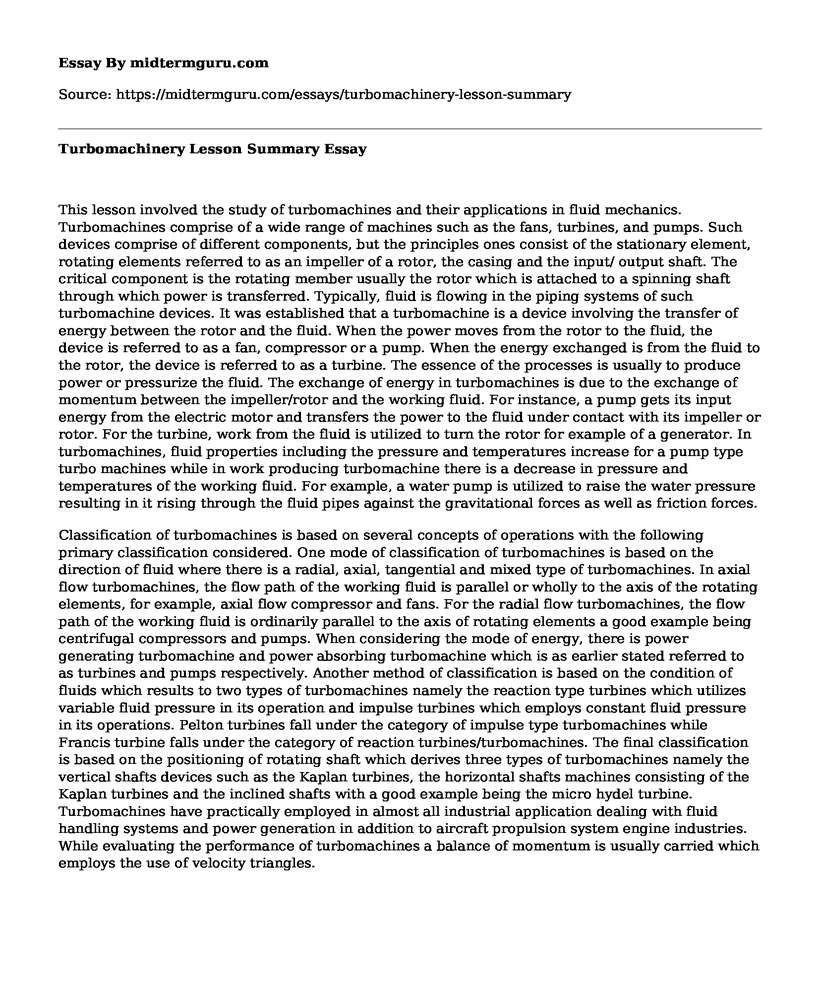This lesson involved the study of turbomachines and their applications in fluid mechanics. Turbomachines comprise of a wide range of machines such as the fans, turbines, and pumps. Such devices comprise of different components, but the principles ones consist of the stationary element, rotating elements referred to as an impeller of a rotor, the casing and the input/ output shaft. The critical component is the rotating member usually the rotor which is attached to a spinning shaft through which power is transferred. Typically, fluid is flowing in the piping systems of such turbomachine devices. It was established that a turbomachine is a device involving the transfer of energy between the rotor and the fluid. When the power moves from the rotor to the fluid, the device is referred to as a fan, compressor or a pump. When the energy exchanged is from the fluid to the rotor, the device is referred to as a turbine. The essence of the processes is usually to produce power or pressurize the fluid. The exchange of energy in turbomachines is due to the exchange of momentum between the impeller/rotor and the working fluid. For instance, a pump gets its input energy from the electric motor and transfers the power to the fluid under contact with its impeller or rotor. For the turbine, work from the fluid is utilized to turn the rotor for example of a generator. In turbomachines, fluid properties including the pressure and temperatures increase for a pump type turbo machines while in work producing turbomachine there is a decrease in pressure and temperatures of the working fluid. For example, a water pump is utilized to raise the water pressure resulting in it rising through the fluid pipes against the gravitational forces as well as friction forces.
Classification of turbomachines is based on several concepts of operations with the following primary classification considered. One mode of classification of turbomachines is based on the direction of fluid where there is a radial, axial, tangential and mixed type of turbomachines. In axial flow turbomachines, the flow path of the working fluid is parallel or wholly to the axis of the rotating elements, for example, axial flow compressor and fans. For the radial flow turbomachines, the flow path of the working fluid is ordinarily parallel to the axis of rotating elements a good example being centrifugal compressors and pumps. When considering the mode of energy, there is power generating turbomachine and power absorbing turbomachine which is as earlier stated referred to as turbines and pumps respectively. Another method of classification is based on the condition of fluids which results to two types of turbomachines namely the reaction type turbines which utilizes variable fluid pressure in its operation and impulse turbines which employs constant fluid pressure in its operations. Pelton turbines fall under the category of impulse type turbomachines while Francis turbine falls under the category of reaction turbines/turbomachines. The final classification is based on the positioning of rotating shaft which derives three types of turbomachines namely the vertical shafts devices such as the Kaplan turbines, the horizontal shafts machines consisting of the Kaplan turbines and the inclined shafts with a good example being the micro hydel turbine. Turbomachines have practically employed in almost all industrial application dealing with fluid handling systems and power generation in addition to aircraft propulsion system engine industries. While evaluating the performance of turbomachines a balance of momentum is usually carried which employs the use of velocity triangles.
Cite this page
Turbomachinery Lesson Summary. (2022, Sep 14). Retrieved from https://midtermguru.com/essays/turbomachinery-lesson-summary
If you are the original author of this essay and no longer wish to have it published on the midtermguru.com website, please click below to request its removal:
- Reserves in Petroleum
- Paper Example on Minimizing Phone Usage
- IKEA's Approach to Innovation - Essay Sample
- The Innovators: A Standard History of the Digital Revolution - Essay Sample
- Cell Phones: Adverse Health Effects & A Sleep Data App - Essay Sample
- Ensuring Water Accessibility - Research Paper
- New Phone: Urban Living Redefined With AI-Enabled Camera - Essay Sample







